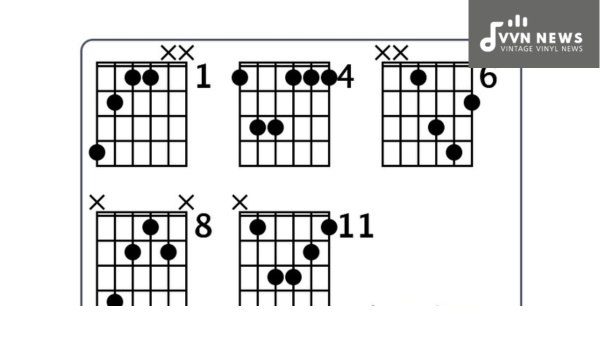As any aspiring rockstar knows, mastering the art of guitar chord construction is like navigating a musical minefield of sharps, flats, and befuddling finger placements. But fear not, fellow strummers! In this article, we will embark on a fretboard expedition to uncover the hidden secrets and complexities behind the creation of those harmonious chords that make our hearts sing (or at least attempt to). So grab your pick, tune your strings, and let’s dive headfirst into the wild world of guitar chordology!
Contents
- 1 Unlocking the Foundations of Guitar Chord Theory
- 2 Diving Deep into Major and Minor Chord Formulations
- 3 Navigating Through the Complex Landscape of Seventh Chords
- 4 Deciphering Extended and Altered Chords for Advanced Play
- 5 Exploring the Role of Chord Inversions in Harmonic Progressions
- 6 Harnessing the Power of Chord Voicings for Expressive Guitar Playing
- 7 FAQs
- 8 Strumming Along…
Unlocking the Foundations of Guitar Chord Theory
Are you tired of feeling like a lost puppy when it comes to understanding guitar chord theory? Well, fear no more because we are here to unlock the mysterious foundations of this musical tool!
First things first, let’s talk about the almighty major chord. This bad boy is made up of three notes – the root, third, and fifth. Don’t worry, we’re not talking about vegetables here! The root note sets the tone (literally) and determines the name of the chord, while the third and fifth add flavor to the mix. Think of it like a musical sandwich – you’ve got your bread (root note) and your tasty fillings (third and fifth)!
Next up, we have the minor chord. This one is like the rebellious teenager of the chord family. It has a sad and melancholic vibe compared to the major chord. The only difference between the two is that the third note is one semitone lower in the minor chord. It’s like going from a sunny day to a rainy one – but in a good way!
Now, let’s not forget about the mysterious seventh chord. This one adds a bit of spice to your musical repertoire. It’s like the major chord with an extra kick – the seventh note. This bad boy can create some jazzy and soulful sounds that will have your audience begging for more!

Diving Deep into Major and Minor Chord Formulations
Ever wonder why major chords sound so cheerful and happy while minor chords sound melancholic and sad? Let’s dive deep into the world of major and minor chord formulations to uncover the secrets behind these contrasting tones!
In music theory, a major chord is made up of a root note, a major third, and a perfect fifth. This perfect harmony creates a sense of joy and exuberance that’ll have you tapping your foot and nodding your head in no time. It’s like a burst of sunshine on a cloudy day, lifting your spirits and putting a smile on your face.
On the other hand, a minor chord consists of a root note, a minor third, and a perfect fifth. This combination of intervals creates a sense of darkness and introspection, like a rainy day when you’d rather stay in bed and ponder the meaning of life. Minor chords are perfect for expressing deep emotions and adding a touch of drama to your music.
So next time you’re jamming out on your guitar or piano, take a moment to appreciate the magic of major and minor chords. They may be simple in theory, but their impact on the mood and feel of a song is truly profound. Embrace the light and the darkness, the joy and the sorrow – that’s the beauty of music!
Seventh chords can be like a tangled web of musical confusion – but fear not, brave musician! With a little navigation and a sprinkle of music theory magic, you can conquer these complex chords and add a touch of sophistication to your compositions.
First off, let’s break down the different types of seventh chords you may encounter in your musical journey:
- Major Seventh (Maj7) - This chord has a dreamy, ethereal quality reminiscent of sipping a fancy cocktail at a jazz club.
- Minor Seventh (m7) – The cool cousin of the major seventh, this chord adds a touch of melancholy and soul to your music.
- Dominant Seventh (7) – Bold and brash, this chord demands attention and will make your listeners sit up and take notice.
Now, when it comes to actually playing these seventh chords, it’s all about finding the right voicings and fingerings on your instrument. Experiment with different inversions and placements to find the sweet spot that suits your musical style.
Remember, practice makes perfect! So don’t be afraid to dive headfirst into the world of seventh chords and explore the rich harmonic possibilities they offer. And who knows, you may just stumble upon a musical gem that takes your compositions to new heights!

Deciphering Extended and Altered Chords for Advanced Play
So, you’ve mastered your basic chords and you’re ready to take your playing to the next level with extended and altered chords. Don’t worry, we’ve got you covered with some tips to make these complex chords a breeze to play!
First off, let’s talk about extended chords. These bad boys add some extra flavor to your playing by incorporating additional notes beyond the basic triad. Some common extended chords include the ninth, eleventh, and thirteenth chords. Just add these notes on top of your regular triad and you’ll be sounding like a pro in no time.
Now, onto altered chords. These chords have some sneaky alterations to the basic triad that give them a unique sound. Altered chords can include flat or sharp notes, as well as added tensions. They may sound a bit dissonant at first, but once you get the hang of them, they can add some serious depth to your playing.
Remember, practice makes perfect when it comes to mastering extended and altered chords. So, don’t be afraid to experiment and get creative with your playing. Before you know it, you’ll be wowing your friends and fans with your advanced chord skills!

Exploring the Role of Chord Inversions in Harmonic Progressions
Have you ever heard a chord inversion and thought, “Wow, that’s like a deliciously spicy twist in a bland musical soup”? Well, that’s essentially what chord inversions bring to the table in harmonic progressions. They add that extra layer of flavor that keeps our ears interested and our musical taste buds satisfied.
Picture this: you’re playing a standard I-IV-V progression in C major, but instead of the usual root positions, you throw in some chord inversions. Suddenly, that tired old progression feels like a brand new adventure. The tonic chord becomes a mysterious stranger, the dominant chord a mischievous trickster, and the subdominant chord a reliable sidekick. It’s like a musical superhero squad ready to save the day!
Embrace the power of chord inversions and let your harmonic progressions soar to new heights. Experiment with different inversions, mix and match them like a mad scientist in a music lab, and watch as your compositions come alive with unexpected twists and turns. Don’t be afraid to break the rules and shake things up – after all, music is meant to be a wild, unpredictable ride!
Harnessing the Power of Chord Voicings for Expressive Guitar Playing
Have you ever felt like your guitar playing lacks that extra oomph? Well, fear not, dear guitar aficionados! The key to unlocking a whole new level of expressiveness lies in harnessing the power of chord voicings. By mastering different chord voicings, you can add depth, emotion, and character to your playing. So, why settle for just strumming the same old open chords when you can level up your game with some fancy voicings?
Picture this: you’re strumming away on your trusty old guitar, feeling like a rockstar. But wait, what’s that? With just a simple switch to a new voicing, you suddenly sound like a jazz virtuoso or a blues legend. The possibilities are endless! So why limit yourself to the same old boring chords, when you can spice things up with some killer voicings?
With different chord voicings at your disposal, you can create unique textures and colors in your playing. Imagine strumming a bold, jazzy voicing that makes heads turn, or a dreamy, ethereal voicing that transports your listeners to another world. The power is in your hands, quite literally! So, why settle for mediocrity when you can dazzle and impress with some killer voicings?
So, dear guitar enthusiasts, the next time you pick up your instrument, remember the magic that chord voicings can bring to your playing. Explore, experiment, and have fun creating your own signature sound. Who knows, you might just become the next guitar hero!
FAQs
What are the basic building blocks of guitar chords?
The basic building blocks of guitar chords are notes, which are grouped together in specific patterns to create different chords. These patterns consist of a combination of root notes, thirds, fifths, and sometimes sevenths.
How do different chord constructions affect the sound of a chord?
Different chord constructions can drastically change the sound of a chord. For example, adding in a seventh to a major chord can give it a jazzy or bluesy feel, while adding in a suspended fourth can create a more dissonant and unresolved sound.
Why is it important to understand the intricacies of guitar chord construction?
Understanding the intricacies of guitar chord construction is crucial for any guitarist looking to expand their musical abilities. By knowing how chords are built and how different notes interact with each other, you can create more interesting and unique chord progressions in your playing.
How can I apply my knowledge of chord construction to my own playing?
Once you understand chord construction, you can start experimenting with creating your own chord shapes and progressions. Try mixing up different chord tones or adding in extra notes to see how it changes the sound of a chord. The possibilities are endless!
Strumming Along…
And there you have it, folks! The wild and wacky world of guitar chord construction. From major to minor, diminished to augmented, we’ve covered it all. So next time you pick up your guitar, remember to give those chords a little love and appreciation for all the intricate work that goes into creating their harmonious sounds. Now go forth, strum with confidence, and serenade the world with your newfound chord knowledge. Rock on!



